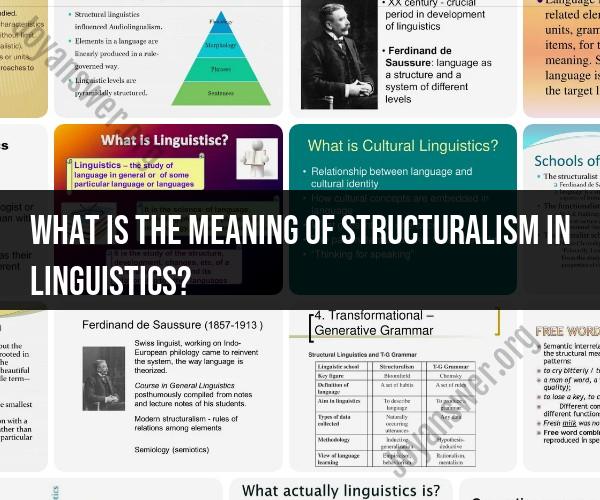What is the meaning of structuralism in linguistics?
Structuralism in linguistics is a theoretical approach to the study of language that emphasizes the analysis of language through its underlying structure, form, and organization. It emerged as a prominent linguistic theory in the early 20th century, with notable contributions from scholars like Ferdinand de Saussure and Roman Jakobson. Structuralism in linguistics can be summarized through several key points:
Language as a System: Structuralists view language as a system of signs and symbols, where words and linguistic elements gain their meaning through their relationships within the system. This means that understanding how elements are structured and interconnected is essential to understanding language.
Synchronic Analysis: Structural linguistics focuses on synchronic analysis, which means studying language as it exists at a particular point in time, rather than tracing its historical development (diachronic analysis). This approach examines the structure of a language as it is used by speakers in a specific linguistic community.
Linguistic Elements: Structuralists identify and analyze the basic linguistic elements, such as phonemes (the smallest sound units), morphemes (the smallest units of meaning), and syntactic structures (sentence and phrase patterns). They examine how these elements combine to form meaningful utterances.
Binary Oppositions: Structuralism often relies on the concept of binary oppositions, where linguistic elements are defined in relation to their opposite or contrasting elements. For example, the concept of "male" is defined in opposition to "female," and "hot" is defined in opposition to "cold."
Saussurian Principles: Ferdinand de Saussure, one of the most influential structural linguists, introduced key ideas like the distinction between langue (the abstract system of language) and parole (individual acts of speech), as well as the concept of the linguistic sign, consisting of a signifier (the sound or written form) and a signified (the concept or meaning).
Phonology and Morphology: Structural linguists pay particular attention to phonology (the study of speech sounds) and morphology (the study of word structure). They seek to identify the regular patterns and rules governing the use of these linguistic elements.
Language Universals: Structuralists were interested in identifying linguistic universals, which are common features or structures found across all languages. By studying these universals, they aimed to uncover fundamental principles underlying language.
It's important to note that structuralism in linguistics was influential in its time but was later challenged and, to some extent, replaced by other linguistic theories, such as generative grammar (associated with Noam Chomsky) and various forms of functional linguistics. However, structuralist ideas continue to inform and influence linguistic research, and some of its concepts, like the distinction between synchronic and diachronic analysis, remain relevant in contemporary linguistics.
Unpacking Linguistics: Exploring the Meaning of Structuralism
Structuralism is a theoretical approach to linguistics that views language as a system of interconnected elements. These elements can be sounds, words, grammatical morphemes, or even larger units such as sentences and paragraphs. Structuralists believe that the meaning of individual linguistic elements is derived from their relationship to other elements in the system.
One of the key concepts of structuralism is the distinction between langue and parole. Langue is the abstract system of language itself, while parole is the specific way that language is used in real-world communication. Structuralists argue that langue is more important than parole for understanding the nature of language.
Another important concept in structuralism is the binary opposition. Binary oppositions are pairs of elements that are contrasted with each other, such as male/female, black/white, and day/night. Structuralists believe that these binary oppositions play a fundamental role in the organization of language.
Structuralism in Language Study: Its Significance and Interpretation
Structuralism has had a major impact on the study of language. It has helped linguists to develop a more sophisticated understanding of how language works and how it is used. Structuralism has also been influential in other fields, such as anthropology, philosophy, and literary criticism.
One of the most significant contributions of structuralism to language study is the idea that language is a system. This view has helped linguists to see how the different elements of language are interconnected and how they work together to produce meaning.
Structuralism has also been influential in the development of new methods for the analysis of language. For example, structuralist linguists have developed techniques for analyzing the sound system, grammatical structure, and meaning of languages.
Linguistic Theory: Understanding Structuralism in Depth
Structuralism is a complex and sophisticated linguistic theory. It is based on a number of key concepts, including:
- Systematicity: Language is a system of interconnected elements.
- Langue and parole: Langue is the abstract system of language itself, while parole is the specific way that language is used in real-world communication.
- Binary oppositions: Binary oppositions are pairs of elements that are contrasted with each other, such as male/female, black/white, and day/night. Structuralists believe that these binary oppositions play a fundamental role in the organization of language.
Structuralism has had a major impact on the study of language and has helped linguists to develop a more sophisticated understanding of how language works and how it is used.
Here are some examples of how structuralism has been used to study language:
- Structuralists have analyzed the sound system of languages to identify the different phonemes that are used in each language.
- Structuralists have also analyzed the grammatical structure of languages to identify the different parts of speech and how they are used to form sentences.
- Structuralists have also studied the meaning of words and sentences, and how meaning is derived from the relationships between different linguistic elements.
Structuralism is a complex and challenging theory, but it has been one of the most influential approaches to linguistics in the 20th century.








